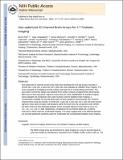Size-optimized 32-channel brain arrays for 3 T pediatric imaging
Author(s)
Keil, Boris; Alagappan, Vijay; Mareyam, Azma; McNab, Jennifer A.; Fujimoto, Kyoko; Tountcheva, Venata; Triantafyllou, Christina; Dilks, Daniel D.; Kanwisher, Nancy; Lin, Weili; Grant, P. Ellen; Wald, Lawrence; ... Show more Show less
DownloadKanwisher-2011-Channel Brain Arrays for 3 T Pediatric Imaging.pdf (2.584Mb)
OPEN_ACCESS_POLICY
Open Access Policy
Creative Commons Attribution-Noncommercial-Share Alike
Terms of use
Metadata
Show full item recordAbstract
Size-optimized 32-channel receive array coils were developed for five age groups, neonates, 6 months old, 1 year old, 4 years old, and 7 years old, and evaluated for pediatric brain imaging. The array consisted of overlapping circular surface coils laid out on a close-fitting coil-former. The two-section coil former design was obtained from surface contours of aligned three-dimensional MRI scans of each age group. Signal-to-noise ratio and noise amplification for parallel imaging were evaluated and compared to two coils routinely used for pediatric brain imaging; a commercially available 32-channel adult head coil and a pediatric-sized birdcage coil. Phantom measurements using the neonate, 6-month-old, 1-year-old, 4-year-old, and 7-year-old coils showed signal-to-noise ratio increases at all locations within the brain over the comparison coils. Within the brain cortex the five dedicated pediatric arrays increased signal-to-noise ratio by up to 3.6-, 3.0-, 2.6-, 2.3-, and 1.7-fold, respectively, compared to the 32-channel adult coil, as well as improved G-factor maps for accelerated imaging. This study suggests that a size-tailored approach can provide significant sensitivity gains for accelerated and unaccelerated pediatric brain imaging.
Date issued
2011-12Department
Harvard University--MIT Division of Health Sciences and Technology; Massachusetts Institute of Technology. Department of Brain and Cognitive Sciences; McGovern Institute for Brain Research at MITJournal
Magnetic Resonance in Medicine
Publisher
Wiley-Blackwell Pubishers
Citation
Keil, Boris et al. “Size-optimized 32-channel Brain Arrays for 3 T Pediatric Imaging.” Magnetic Resonance in Medicine 66.6 (2011): 1777–1787. Web.
Version: Author's final manuscript
ISSN
0740-3194
1522-2594